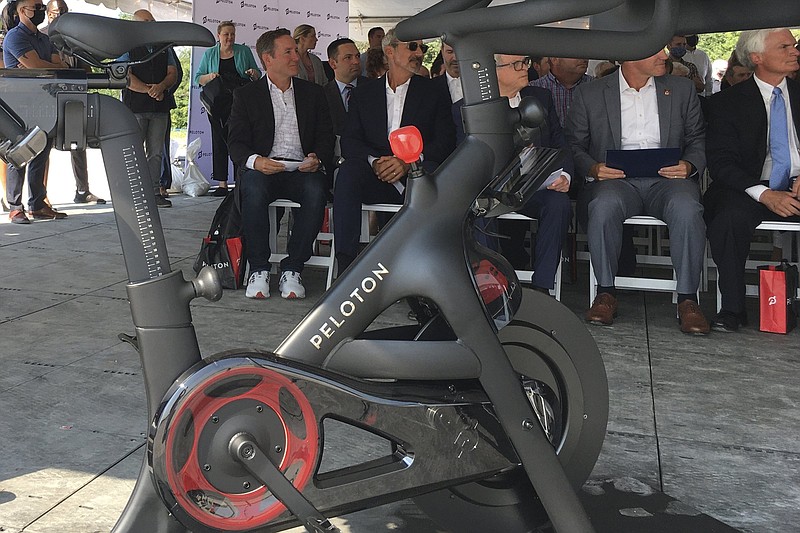Peloton suffered its worst day as a publicly traded company Friday after telling investors that it will likely lose more money than it had expected in fiscal 2022.
Peloton's stock fell $30.42, or 35%, to close Friday at $56.64. It was the worst trading day for the company just 10 months after its shares hit an all-time high above $171. Even before the swoon, Peloton shares were down 43% this year.
The company cut its annual revenue forecast by as much as $1 billion and lowered its projections for subscribers and profit margins.
The fitness company -- best known for its exercise bikes and remote classes -- now expects sales of $4.4 billion to $4.8 billion in fiscal 2022, which ends in June. Less than three months ago, it had been predicting revenue of $5.4 billion. On an earnings call with analysts, Peloton said it underestimated the impact of economic reopenings.
Peloton was a pandemic phenomenon, with customers flocking to home-exercise services during lockdowns. Now people are heading back to the office, school and gyms, sapping demand for the company's equipment. Supply-chain constraints, as well as the soaring costs of commodities and freight, also are weighing on Peloton.
"We anticipated fiscal 2022 would be a very challenging year to forecast," management said in a letter to shareholders Thursday. "We will be taking concrete steps to reexamine our expense base and adjust our operating costs."
At best, Peloton currently expects to have 3.45 million connected fitness subscriptions by the end of the fiscal year. It had previously called for 3.63 million. And gross profit margin will be 32%, compared with an earlier forecast of 34%. All that will add up to a loss of as much as $475 million, excluding some items.
On Peloton's earnings call, co-founder and Chief Executive Officer John Foley said the "swift" change in its outlook is "not lost on us" and that visibility into its future performance has become more limited. Executives added that traffic to Peloton's retail stores and website tapered more than anticipated, but the company saw positive response to price changes and launches internationally, particularly in Australia.
The company cut the price of its original bike by $400 in August, and that too has hurt profitability -- especially since more shoppers than expected opted for that model over other products.
[Video not showing up above? Click here to watch » arkansasonline.com/116peloton]
"A softer-than-anticipated start" to the second fiscal quarter contributed to the company's decision to rethink its forecast, according to the letter. But Peloton added that its "confidence in and commitment to our strategy is unchanged."
Like several other companies, Peloton also blamed Apple's ad-related privacy changes, which have made it more difficult to target shoppers based on their interests.
LOOKING TO 2023
Efforts to rein in costs probably won't begin to show up for a quarter or two, the New York-based company said. Peloton expects to be profitable -- before interest, taxes, depreciation and amortization -- by fiscal 2023.
Revenue rose 6% to $805.2 million last quarter. That was just above Peloton's $800 million forecast, but below the roughly $809 million anticipated by analysts. The company posted a net loss of $1.25 a share.
The slim growth came from a 94% increase in revenue from subscriptions, which totaled $304.1 million. Hardware sales fell 17% to $501 million in the first quarter.
Peloton expects to report between $1.1 billion and $1.2 billion in revenue for in the second fiscal quarter, which ends in December. That would miss Wall Street estimates of $1.5 billion. It's projecting 2.8 million to 2.85 million in total fitness subscribers by the end of the period.
NEW PRODUCTS
On a more upbeat note, the company hinted that it plans to launch new products in the coming weeks and months. Peloton has been working on a rowing machine and a heart-rate monitor that attaches to a wearer's arm, Bloomberg News has reported.
Peloton previously introduced a line of treadmills, but had to recall both models in May. In August, it brought back the lower-end treadmill, but not the more expensive version, which was linked to a child's death.
On its call Thursday, Peloton said that it expects the first fiscal quarter to be the "trough" of its results for fiscal 2022 and that inventories are healthy going into the holiday season. But its Precor business -- a division acquired this year that sells workout machines to gyms, hotels and dorms -- has faced supply-chain struggles.
As people continue to return to the office, the average number of monthly workouts fell to 16.6 per subscription from 20.7 a year earlier. In-person gyms, meanwhile, are seeing their fortunes recover. Planet Fitness jumped to a record high on Thursday after delivering a better-than-anticipated forecast.
Peloton also is trying to shed its upscale image, which may put off many middle-class consumers.
"There remains a lingering perception that Peloton is a luxury item," the company said. "We intend to amplify the platform's value proposition via increased marketing ahead of and during our key seasonal selling period."
Information for this article was contributed by Matt Ott of The Associated Press.
